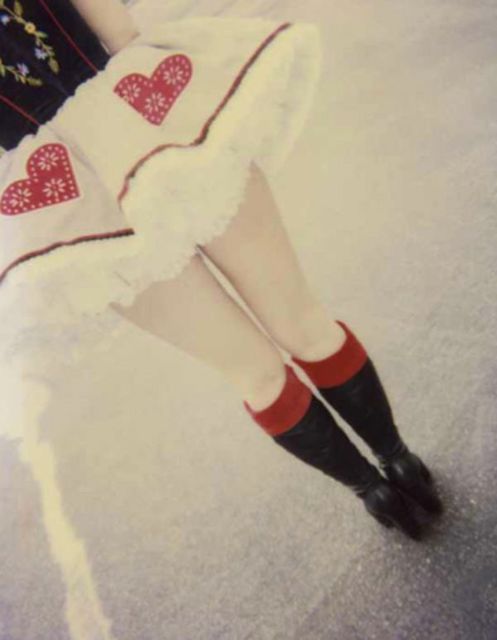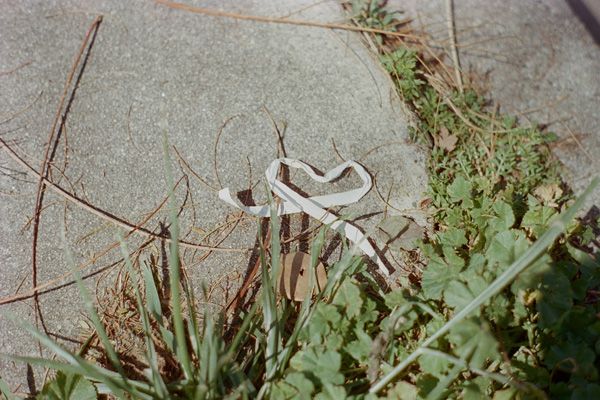 . Find It In Everything swims in the shallow end, and Barrymore’s innate celebrity fails to elevate the effort. The photographic and literary execution here is awash in lack. Amateurish photos are offset by vapid, folksy ramblings. This stuff reads like a cutesy counterpoint to fellow rom-com alum Matthew McConaughey’s commercials for Lincoln Motors. Drew with the bent straw wrapper “find[s] hope where [she] least expects it.” Drew with a tea bag realizes “it [is] going to be a good day.” Drew with the water stain, the torn T-shirt, the refracted light, the cats and the dogs, the tattoos, the bitten apple, the carpet … and hearts. And more hearts.I am not a heart-hating shrew. But the vast majority of hearts “found” by Barrymore are both man-made and shot with a minimum of compositional sense. A lack of attention to basic photographic principles makes me wonder if these hearts may have been better off lost. Depth, symmetry, white balance, a defined point of view and framing are all in scarce supply. But the underwhelming photos—a plastic bread-clip, the curve of a wrought-iron chair, the dregs of a pho bowl, textures from the urban jungle, the depths of a bathroom mirror and so on—abound. Barrymore’s heart might be in the right place but Find It In Everything proves she’s just not that into photography.
. Find It In Everything swims in the shallow end, and Barrymore’s innate celebrity fails to elevate the effort. The photographic and literary execution here is awash in lack. Amateurish photos are offset by vapid, folksy ramblings. This stuff reads like a cutesy counterpoint to fellow rom-com alum Matthew McConaughey’s commercials for Lincoln Motors. Drew with the bent straw wrapper “find[s] hope where [she] least expects it.” Drew with a tea bag realizes “it [is] going to be a good day.” Drew with the water stain, the torn T-shirt, the refracted light, the cats and the dogs, the tattoos, the bitten apple, the carpet … and hearts. And more hearts.I am not a heart-hating shrew. But the vast majority of hearts “found” by Barrymore are both man-made and shot with a minimum of compositional sense. A lack of attention to basic photographic principles makes me wonder if these hearts may have been better off lost. Depth, symmetry, white balance, a defined point of view and framing are all in scarce supply. But the underwhelming photos—a plastic bread-clip, the curve of a wrought-iron chair, the dregs of a pho bowl, textures from the urban jungle, the depths of a bathroom mirror and so on—abound. Barrymore’s heart might be in the right place but Find It In Everything proves she’s just not that into photography. Book Review - Find It In Everything: Photographs By Drew Barrymore
Book Review - Find It In Everything: Photographs By Drew Barrymore

 . Find It In Everything swims in the shallow end, and Barrymore’s innate celebrity fails to elevate the effort. The photographic and literary execution here is awash in lack. Amateurish photos are offset by vapid, folksy ramblings. This stuff reads like a cutesy counterpoint to fellow rom-com alum Matthew McConaughey’s commercials for Lincoln Motors. Drew with the bent straw wrapper “find[s] hope where [she] least expects it.” Drew with a tea bag realizes “it [is] going to be a good day.” Drew with the water stain, the torn T-shirt, the refracted light, the cats and the dogs, the tattoos, the bitten apple, the carpet … and hearts. And more hearts.I am not a heart-hating shrew. But the vast majority of hearts “found” by Barrymore are both man-made and shot with a minimum of compositional sense. A lack of attention to basic photographic principles makes me wonder if these hearts may have been better off lost. Depth, symmetry, white balance, a defined point of view and framing are all in scarce supply. But the underwhelming photos—a plastic bread-clip, the curve of a wrought-iron chair, the dregs of a pho bowl, textures from the urban jungle, the depths of a bathroom mirror and so on—abound. Barrymore’s heart might be in the right place but Find It In Everything proves she’s just not that into photography.
. Find It In Everything swims in the shallow end, and Barrymore’s innate celebrity fails to elevate the effort. The photographic and literary execution here is awash in lack. Amateurish photos are offset by vapid, folksy ramblings. This stuff reads like a cutesy counterpoint to fellow rom-com alum Matthew McConaughey’s commercials for Lincoln Motors. Drew with the bent straw wrapper “find[s] hope where [she] least expects it.” Drew with a tea bag realizes “it [is] going to be a good day.” Drew with the water stain, the torn T-shirt, the refracted light, the cats and the dogs, the tattoos, the bitten apple, the carpet … and hearts. And more hearts.I am not a heart-hating shrew. But the vast majority of hearts “found” by Barrymore are both man-made and shot with a minimum of compositional sense. A lack of attention to basic photographic principles makes me wonder if these hearts may have been better off lost. Depth, symmetry, white balance, a defined point of view and framing are all in scarce supply. But the underwhelming photos—a plastic bread-clip, the curve of a wrought-iron chair, the dregs of a pho bowl, textures from the urban jungle, the depths of a bathroom mirror and so on—abound. Barrymore’s heart might be in the right place but Find It In Everything proves she’s just not that into photography. 
It takes a good eye to find hearts where … someone put them.

Truly

the world is a magical place.

Cross my heart and hope to die. For realz.

Why do I suspect her assistant took this one?








